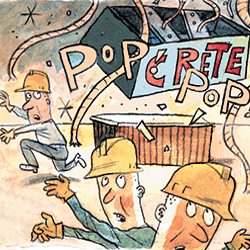It seemed that one of my crates destined for Las Vegas was sitting on our coffee supplier's loading dock in the state of Virginia. That meant it was not going to be sitting at the venue ready to be set up for the show.

If there's one thing I've learned as an exhibit manager, it's to never believe for a minute that I've seen it all when it comes to trade show snafus. The reality is that there are so many moving parts in this industry that the human mind cannot even begin to calculate the number of ways in which things can go outlandishly, horribly wrong.
This kernel of wisdom was thrust upon me recently when I was preparing to exhibit at a show in Las Vegas. My company, located in Tampa, FL, had a 10-by-10-foot booth that I needed to ship to the venue along with various other supplies, including hundreds of blinking buttons we planned to give away. I needed to keep all those buttons and other small items from tumbling around inside of the crates, so I grabbed a cardboard box that our company's coffee shipment had arrived in and put all the little stuff inside. I packed the box and everything else nicely into three plastic crates, and then I slapped shipping labels onto them and sent them on their merry way.
A few days later, right about the time our crates should have been arriving in Vegas, I was sitting at my desk when the receptionist buzzed me and said something very peculiar: "Line one. The coffee company has a question for you."
Now I should mention that while I am a fan of our coffee at work, I had absolutely nothing to do with the company we ordered it from. So unless it had the best customer outreach program on Earth and wanted to know my personal feelings about its java, the rep was obviously asking for the wrong guy. I picked up the phone anyway with a curious, "Hello?"
On the other end was a woman, and she was mad as hell. "Why are you using our shipping account?" she demanded to know. This sounded like gibberish to me, because why would I use the coffee company's shipping account? So of course I denied it, and she got even angrier, insisting that I most certainly knew all about this, and she was not going to stand for it.
I had absolutely no idea what she was talking about, but as she was ranting, I picked up a few keywords – shipping crate, buttons, the coffee company dock – and a prickle of fear ran down my spine. It seemed that one of my crates destined for Las Vegas was sitting on our coffee supplier's loading dock, in a blizzard no less, in the state of Virginia. Why it was there, I didn't know, but this meant it was not going to be sitting at the venue ready to be set up when my boss arrived for the show in 24 hours.

To be sure it was mine, I asked the woman what was in the crate, and she described random things, including buttons that were scattered everywhere, and a shipping box from the coffee company. The disheveled crate had arrived on her dock that day with a broken lock and a couple of straps barely holding the now ill-fitting lid on the container. Based on her description, I knew it was our crate, but I wasn't any closer to understanding why it was sitting on a dock in Virginia, so I hung up and called the shipping company.
When the shipper finally managed to trace the misadventures of this crate, he offered a story that was almost too outlandish to be true. Almost. It seemed the shipping label on the crate had come off at some point between when it left my company and when it was carried into a large shipment-processing warehouse. With no label, the crate got pulled off to the side where some workers, bless their hearts, decided to try to discover its intended destination.
So they took something – probably a sledge hammer from the looks of it – and broke the lock on the crate so they could open it. Rifling through the buttons and literature inside yielded no clues, but one of the workers noticed a shipping label on the coffee company box, and it happened to be a label from that company. For reasons that will forever be a mystery to me, someone decided we must have been sending those things to the coffee company, so off it went to Virginia.
I implored the person on the phone politely to go pick it back up and overnight it to Las Vegas, and at the firm's expense, thank you very much. In dead seriousness, the shipper told me that the firm couldn't pick up the crate because it wasn't fit for shipping since the lid was no longer secure. I laughed out loud when he said this because it was so preposterous. But really, it was not funny at all. I decided to deal with the shipper later, however, because my first priority was to get that crate to Las Vegas.
Back on the phone with the woman at the coffee company, I explained the lunacy that had transpired, and while she stopped yelling at me, she also warned me there would be hell to pay if her company was charged for the crate delivery. I promised her I would take care of it and asked if there was anyone in her shipping department who could help me. She transferred me to a nice guy who offered to shrink-wrap the entire container and put a new shipping label on it. So I emailed a new label directly to the coffee company and told the shipper to head over there to pick up an overnight package. I called my boss to let him know the crate was well on its way.
Once the show was over, I battled with the shipping company for months until it agreed to eat all the charges. And though I'll never understand the logic in the shipper's decisions, I now ward off future incidents with loads of adhesive labels, another label inside the cover, and a swipe of thick black marker through anything that even remotely looks like a shipping label on containers inside. It might not fix all the evils of trade show shipping, but at least I don't have to be afraid of the coffee lady anymore.
— Martin Grobisen, product marketing manager, Sunview Software Inc., Tampa, FL




 If there's one thing I've learned as an exhibit manager, it's to never believe for a minute that I've seen it all when it comes to trade show snafus. The reality is that there are so many moving parts in this industry that the human mind cannot even begin to calculate the number of ways in which things can go outlandishly, horribly wrong.
If there's one thing I've learned as an exhibit manager, it's to never believe for a minute that I've seen it all when it comes to trade show snafus. The reality is that there are so many moving parts in this industry that the human mind cannot even begin to calculate the number of ways in which things can go outlandishly, horribly wrong.  To be sure it was mine, I asked the woman what was in the crate, and she described random things, including buttons that were scattered everywhere, and a shipping box from the coffee company. The disheveled crate had arrived on her dock that day with a broken lock and a couple of straps barely holding the now ill-fitting lid on the container. Based on her description, I knew it was our crate, but I wasn't any closer to understanding why it was sitting on a dock in Virginia, so I hung up and called the shipping company.
To be sure it was mine, I asked the woman what was in the crate, and she described random things, including buttons that were scattered everywhere, and a shipping box from the coffee company. The disheveled crate had arrived on her dock that day with a broken lock and a couple of straps barely holding the now ill-fitting lid on the container. Based on her description, I knew it was our crate, but I wasn't any closer to understanding why it was sitting on a dock in Virginia, so I hung up and called the shipping company. 


